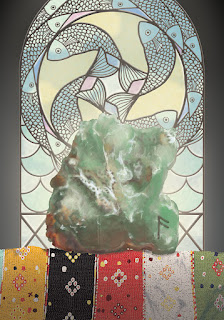Alessia Delvecchio
"Chrysoprase”,
digital painting print on gatorfoam
(1/50) 100x140x2cm, 2023
In "Chrysoprase", la cui traduzione è Crisoprasio, viene rappresentato il minerale in primo piano con incisa la runa Ansuz la cui capacità è di aumentare le abilità comunicative ed espressive. Il Crisoprasio è indicato come decima pietra di fondazione delle mura della Città Santa nell’apocalisse di Giovanni e indica l’apostolo Andrea. La pietra poggia sopra un tappeto kilim Qashqai, del XIX secolo, di Farsi. Il tappeto è un omaggio al divino e per sua natura crea un’atmosfera mistica, ad ogni nodo intrecciato è legato il pensiero di chi lo ha lavorato dedicandovi ore della propria vita. Su di un tappeto persiano è stato scritto: “Hanno filato la sua trama col filo dell’anima”.
Gli attributi di Andrea sono la croce decussata, i pesci e la rete da pesca, rappresentati nella vetrata che fa da sfondo. Questo lavoro appartiene alla serie intitolata "Way back into Soul", in cui sono rappresentati antichi miti in chiave moderna.
In “Chrysoprase", the mineral is represented in the foreground engraved with the Ansuz rune, whose ability is to increase communication and expressive skills. Chrysoprase is indicated as the tenth foundation stone of the walls of the Holy City in the apocalypse of John and indicates the apostle Andrew. The stone rests on a 19th-century kilim Qashqai carpet from Farsi. The carpet is a tribute to the divine and by its nature creates a mystical atmosphere, the thoughts of those who worked on it are linked to each intertwined knot, dedicating hours of their lives to it. On a Persian carpet it was written: "They spun its weft with the thread of the soul". Andrew's attributes are the diagonal cross, the fish and the fishing net, represented in the stained glass window in the background.This work belongs to a series entitled "Way back into Soul", in which ancient myths are represented in a modern way.



